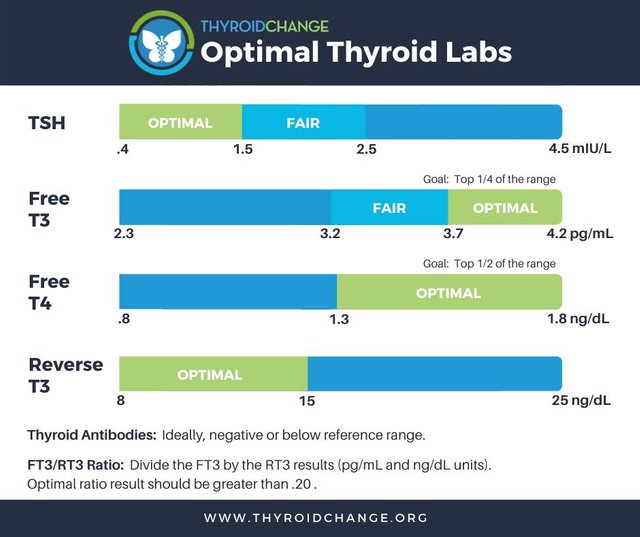ARE YOUR THYROID LABS OPTIMAL?
Is your doctor testing more than just TSH? He/she should be and there is a BIG difference between "in reference range" and being in OPTIMAL range. Many patients can still be horribly symptomatic within the normal, broad reference range.
Pay attention to the:
💚 Light green OPTIMAL levels in the chart
This is where you want your levels to be.
ThyroidChange has researched the optimal ranges from integrative practitioners who specialize in hormone imbalance and they are listed in this guide. These labs are the basics for monitoring thyroid function, or for any patient exhibiting symptoms.

Note: The numbers listed in the chart are using Quest Diagnostics reference ranges. However, many labs have a similar range. If you are unsure, simply remember this:
👉Free T3 should be in the TOP 1/4 of the range.
👉Free T4 should be in the TOP 1/2 of the range.
👉TSH should be closer to 1.0 .
Note: If your are on natural desiccated thyroid medication or any T3-containing medication, your TSH will naturally be suppressed or below the reference range. This is normal.
👉 Reverse T3 should be no higher than 15, according to most of our supporting practitioners. However, one must also look at the RT3:FT3 ratio. It should be greater than .20 if you divide the FT3 result by the RT3 result using pg/mL and ng/dL units.
Example: 3.8 (FT3) ÷ 9 (RT3) = .42
The result is a good ratio since it's above .20. This means that this person is not likely experiencing a blocking of thyroid hormone at the cellular level.
For the most consistent and accurate results, testing should always be done in the morning prior to taking food and any thyroid medication. If you keep your lab testing consistent like this, it is always be "apples to apples". 🍏 👍 Consistency is the key.